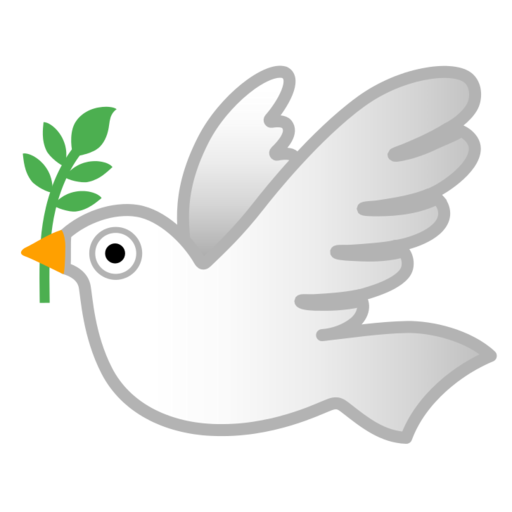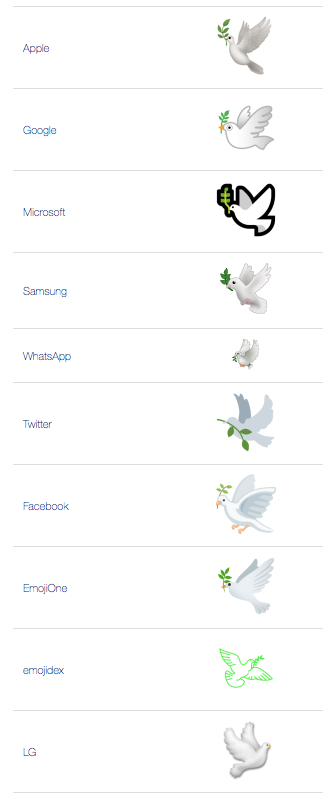What Does the Dove Emoji 🕊 Mean?
Emojis have transformed digital communication, adding nuance and emotion to text-based conversations. Among them, the dove emoji stands out as a symbol of peace, love, and spirituality. But what does it truly mean when someone sends you this emoji? Is it just a random bird, or does it carry a deeper message?
At FEC Vietnam, we explore the intricate meanings behind emojis to ensure you interpret them correctly. The dove emoji is more than just a simple representation of a bird; it has profound cultural, historical, and religious significance.
The Dove as a Symbol of Peace and Harmony
One of the most recognized meanings of the dove emoji is peace. Throughout history, doves have been linked to non-violence, reconciliation, and harmony.
Historical Origins of the Dove as a Peace Symbol
- Ancient Greece & Rome: Doves were associated with Eirene, the Greek goddess of peace, and Venus, the Roman goddess of love. They were depicted carrying olive branches, which later became an international symbol of peace.
- Biblical References: The dove appears in the story of Noah’s Ark, carrying an olive leaf as a sign that the flood had ended (Genesis 8:11). This cemented the dove’s role as a symbol of divine peace and hope.
- Post-World War II: The famous Spanish artist Pablo Picasso designed the “Dove of Peace” poster for the World Peace Congress in 1949, solidifying its modern association with global harmony.
In today’s digital world, sending the dove emoji can mean:
✅ Seeking peace – Used to de-escalate conflicts or propose reconciliation.
✅ Promoting harmony – Sent in messages about unity and mutual understanding.
✅ Supporting anti-violence movements – Often included in posts advocating world peace.
Example:
“No more fighting, let’s move forward in peace 🕊.”
Religious and Spiritual Significance of the Dove Emoji
Beyond peace, the dove emoji has deep spiritual connotations in major religions.
Christianity: The Dove as the Holy Spirit
In Christianity, the dove is a direct representation of the Holy Spirit. When Jesus was baptized, the Holy Spirit descended “like a dove” (Matthew 3:16), symbolizing divine blessing and purity.
- Doves are often depicted in religious artwork, signifying God’s presence.
- Churches use the dove symbol on stained glass windows and banners.
- The Pope has released white doves on several occasions as a sign of peace.
Judaism & Islam: A Divine Messenger
- In Judaism, doves are seen as pure creatures and are often referenced in biblical texts. The Hebrew word for dove, “Yonah”, is the same as the prophet Jonah’s name, linking it to themes of mercy and redemption.
- In Islam, doves are believed to have protected Prophet Muhammad by covering the entrance of the cave he hid in during his escape from Mecca, demonstrating divine protection.
Example of religious messaging using the dove emoji:
“May the Holy Spirit guide you in your journey 🕊🙏.”
Love, Hope, and Freedom: The Deeper Meaning of the Dove Emoji
The dove is not just a symbol of peace—it also represents love, hope, and liberation in many cultures.
Love & Romance: The Dove as a Symbol of Devotion
- Greek & Roman mythology linked doves to Aphrodite/Venus, the goddess of love.
- Weddings frequently feature white doves, as their lifelong pair bonding symbolizes eternal love and commitment.
Example:
“You are my peace and my love 🕊❤️.”
Hope & Renewal: The Dove as a Messenger of Good News
- The phrase “When doves cry” (popularized by Prince) symbolizes deep sorrow, but also the idea that peace is needed in times of hardship.
- White doves are released at funerals and memorials, signifying the soul’s journey to the afterlife and eternal peace.
Example:
“Sending love and hope your way 🕊💖.”
Freedom & Liberation: The Dove as a Symbol of Release
- In many cultures, releasing doves represents letting go of burdens, starting anew, or setting someone free.
- During major political movements, doves have been used to symbolize freedom from oppression.
Example:
“A new chapter begins, full of peace and possibilities 🕊✨.”
This is the first half of the article. The second half will cover modern uses of the dove emoji, its role in digital communication, cultural interpretations, and how it compares to similar emojis. Stay tuned!
Common Uses of the Dove Emoji in Digital Communication
In today’s digital world, emojis have evolved into an essential part of online conversations. The dove emoji is not just a simple pictogram; it carries nuanced meanings depending on the context, platform, and sender’s intention. At FEC Vietnam, we track these evolving uses to help you stay ahead of emoji trends.
1. Expressing Peace and Reconciliation
One of the most common uses of the dove emoji is to convey peace, forgiveness, and resolution. It is frequently included in messages aimed at ending conflicts or promoting unity.
Example situations:
- Personal Conflicts: Someone apologizing for a past misunderstanding might send a message like,
“I never meant to hurt you. Let’s move forward in peace.” 🕊 - Political and Social Movements: Activists and peace organizations use the dove emoji in online campaigns advocating non-violence and diplomacy.
- Global Peace Events: During international days such as the International Day of Peace (September 21st), social media is flooded with posts featuring the dove emoji alongside hashtags like #WorldPeace and #SpreadLove.
A great historical example is Mahatma Gandhi, who promoted non-violent resistance. If emojis had existed in his time, his famous quote,
“An eye for an eye will only make the whole world blind,”
could have easily been accompanied by the dove emoji as a universal sign of peace.
2. Romantic and Emotional Messaging
The dove emoji can also symbolize deep love, devotion, and emotional purity. This makes it particularly common in romantic or sentimental contexts.
How people use it in romantic messages:
✅ Long-distance relationships – “No matter the distance, my love for you is always pure and free.” 🕊❤️
✅ Weddings and anniversaries – “Celebrating a love as peaceful and everlasting as a dove.”
✅ Breaking up on good terms – “We may be parting ways, but I wish you nothing but peace and happiness.”
In literature and poetry, white doves are often used as a metaphor for soulmates. Famous love poets like Pablo Neruda and Shakespeare have described love as a bird that is delicate yet strong—just like the symbolism behind the dove emoji.
3. Spiritual and Inspirational Contexts
The dove is a universal spiritual symbol, and this meaning carries over into its emoji usage. It is frequently used in prayers, motivational messages, and religious discussions.
Examples of spiritual uses:
- Christianity: “May the Holy Spirit be with you always.” 🕊
- Memorial and funeral tributes: “Rest in peace, your soul is now free like a dove.”
- Motivational messages: “Let your spirit soar freely and embrace new beginnings.”
One of the most well-known biblical references to doves is from Genesis 8:11, where Noah receives an olive-branch-bearing dove as a sign that the flood has ended. Today, this story is often referenced in religious services, with the dove emoji reinforcing the message of divine hope and salvation.
Cultural and Historical Context of the Dove Symbol
The dove is not just a religious or romantic symbol—it carries powerful meanings in different cultural and historical contexts worldwide.
Ancient Civilizations and the Dove Symbol
The symbolism of the dove dates back thousands of years, appearing in multiple civilizations:
| Culture | Dove Symbolism |
|---|---|
| Ancient Greece | Associated with Aphrodite, goddess of love, as a symbol of romance and purity. |
| Roman Empire | Linked to Venus, carrying messages of love and desire. |
| Egyptian Mythology | Represented innocence and divine messengers in their spiritual texts. |
| Chinese Culture | Seen as a sign of longevity and peaceful transitions. |
The Dove as a Global Peace Symbol
The modern association of the dove with peace was popularized by Pablo Picasso in 1949 when he created the famous “Dove of Peace” artwork for the World Peace Congress. This image was adopted worldwide as a symbol of anti-war movements, especially during the Cold War and Vietnam War protests.
In recent times, international organizations such as the United Nations and Amnesty International frequently use the dove emblem in their campaigns. The dove emoji has become an instant visual shorthand for these global messages of peace.
Similar Emojis and Their Meanings
While the dove emoji is widely recognized, it can sometimes be confused with other bird-related emojis. Here’s how it compares:
| Emoji | Meaning | How It Differs from the Dove |
|---|---|---|
| 🕊 Dove | Peace, love, spirituality | Pure, uplifting meaning with religious and peaceful associations. |
| 🐦 Generic Bird | Freedom, nature, songbirds | Lacks the cultural weight of the dove. |
| 🦜 Parrot | Communication, mimicry, fun | Often used in humorous or tropical contexts. |
| 🦢 Swan | Elegance, romance, beauty | More associated with luxury and grace than peace. |
If someone sends you a dove emoji, they are likely expressing something deeper and more meaningful than just talking about birds!
Final Thoughts: The Power of the Dove Emoji
The dove emoji is more than just a simple pictogram—it carries a profound history and emotional depth. Whether used to promote peace, express love, or share spiritual messages, this emoji transcends cultural and linguistic barriers.
At FEC Vietnam, we recognize that understanding emoji meanings is crucial in the digital age. The way we use emojis reflects our values, emotions, and even our cultural backgrounds. That’s why we continuously research and track emoji trends, ensuring that you have the most accurate, up-to-date insights on their meanings and usage.
The next time you see the dove emoji, remember that it’s not just a bird—it’s a symbol of peace, hope, and profound human connection. Whether you use it in texts, social media posts, or heartfelt messages, this tiny icon carries a timeless message of love and unity.
For more insights on emoji meanings, visit fecvietnam.edu.vn—your trusted source for decoding digital communication.


